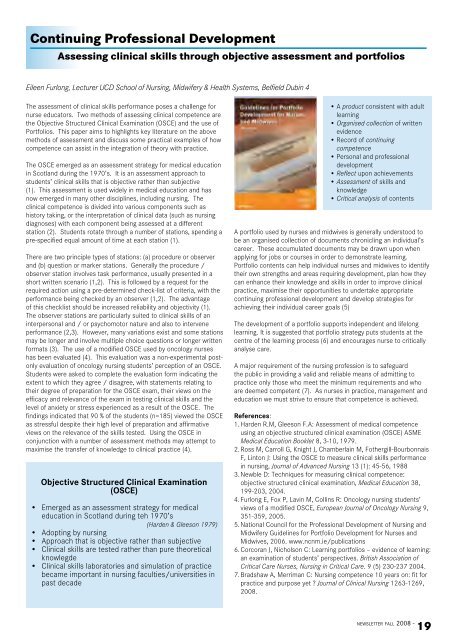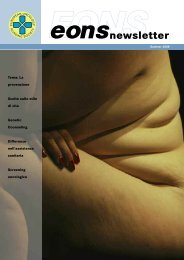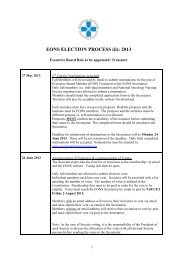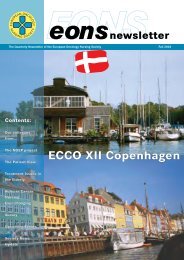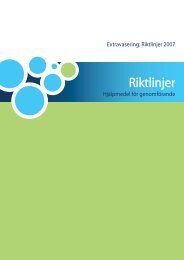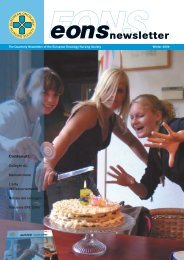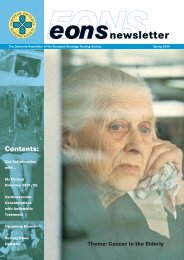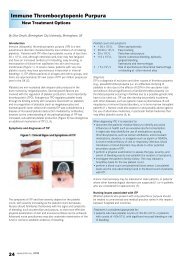English - the European Oncology Nursing Society
English - the European Oncology Nursing Society
English - the European Oncology Nursing Society
- No tags were found...
Create successful ePaper yourself
Turn your PDF publications into a flip-book with our unique Google optimized e-Paper software.
Continuing Professional DevelopmentAssessing clinical skills through objective assessment and portfoliosEileen Furlong, Lecturer UCD School of <strong>Nursing</strong>, Midwifery & Health Systems, Belfield Dubin 4The assessment of clinical skills performance poses a challenge fornurse educators. Two methods of assessing clinical competence are<strong>the</strong> Objective Structured Clinical Examination (OSCE) and <strong>the</strong> use ofPortfolios. This paper aims to highlights key literature on <strong>the</strong> abovemethods of assessment and discuss some practical examples of howcompetence can assist in <strong>the</strong> integration of <strong>the</strong>ory with practice.The OSCE emerged as an assessment strategy for medical educationin Scotland during <strong>the</strong> 1970’s. It is an assessment approach tostudents’ clinical skills that is objective ra<strong>the</strong>r than subjective(1). This assessment is used widely in medical education and hasnow emerged in many o<strong>the</strong>r disciplines, including nursing. Theclinical competence is divided into various components such ashistory taking, or <strong>the</strong> interpretation of clinical data (such as nursingdiagnoses) with each component being assessed at a differentstation (2). Students rotate through a number of stations, spending apre-specified equal amount of time at each station (1).There are two principle types of stations: (a) procedure or observerand (b) question or marker stations. Generally <strong>the</strong> procedure /observer station involves task performance, usually presented in ashort written scenario (1,2). This is followed by a request for <strong>the</strong>required action using a pre-determined check-list of criteria, with <strong>the</strong>performance being checked by an observer (1,2). The advantageof this checklist should be increased reliability and objectivity (1).The observer stations are particularly suited to clinical skills of aninterpersonal and / or psychomotor nature and also to interveneperformance (2,3). However, many variations exist and some stationsmay be longer and involve multiple choice questions or longer writtenformats (3). The use of a modified OSCE used by oncology nurseshas been evaluated (4). This evaluation was a non-experimental postonlyevaluation of oncology nursing students’ perception of an OSCE.Students were asked to complete <strong>the</strong> evaluation form indicating <strong>the</strong>extent to which <strong>the</strong>y agree / disagree, with statements relating to<strong>the</strong>ir degree of preparation for <strong>the</strong> OSCE exam, <strong>the</strong>ir views on <strong>the</strong>efficacy and relevance of <strong>the</strong> exam in testing clinical skills and <strong>the</strong>level of anxiety or stress experienced as a result of <strong>the</strong> OSCE. Thefindings indicated that 90 % of <strong>the</strong> students (n=185) viewed <strong>the</strong> OSCEas stressful despite <strong>the</strong>ir high level of preparation and affirmativeviews on <strong>the</strong> relevance of <strong>the</strong> skills tested. Using <strong>the</strong> OSCE inconjunction with a number of assessment methods may attempt tomaximise <strong>the</strong> transfer of knowledge to clinical practice (4).Objective Structured Clinical Examination(OSCE)• Emerged as an assessment strategy for medicaleducation in Scotland during teh 1970’s(Harden & Gleeson 1979)• Adopting by nursing• Approach that is objective ra<strong>the</strong>r than subjective• Clinical skills are tested ra<strong>the</strong>r than pure <strong>the</strong>oreticalknowlegde• Clinical skills laboratories and simulation of practicebecame important in nursing faculties/universities inpast decade• A product consistent with adultlearning• Organised collection of writtenevidence• Record of continuingcompetence• Personal and professionaldevelopment• Reflect upon achievements• Assessment of skills andknowledge• Critical analysis of contentsA portfolio used by nurses and midwives is generally understood tobe an organised collection of documents chronicling an individual’scareer. These accumulated documents may be drawn upon whenapplying for jobs or courses in order to demonstrate learning.Portfolio contents can help individual nurses and midwives to identify<strong>the</strong>ir own strengths and areas requiring development, plan how <strong>the</strong>ycan enhance <strong>the</strong>ir knowledge and skills in order to improve clinicalpractice, maximise <strong>the</strong>ir opportunities to undertake appropriatecontinuing professional development and develop strategies forachieving <strong>the</strong>ir individual career goals (5)The development of a portfolio supports independent and lifelonglearning. It is suggested that portfolio strategy puts students at <strong>the</strong>centre of <strong>the</strong> learning process (6) and encourages nurse to criticallyanalyse care.A major requirement of <strong>the</strong> nursing profession is to safeguard<strong>the</strong> public in providing a valid and reliable means of admitting topractice only those who meet <strong>the</strong> minimum requirements and whoare deemed competent (7). As nurses in practice, management andeducation we must strive to ensure that competence is achieved.References:1. Harden R.M, Gleeson F.A: Assessment of medical competenceusing an objective structured clinical examination (OSCE) ASMEMedical Education Booklet 8, 3-10, 1979.2. Ross M, Carroll G, Knight J, Chamberlain M, Fo<strong>the</strong>rgill-BourbonnaisF, Linton J: Using <strong>the</strong> OSCE to measure clinical skills performancein nursing, Journal of Advanced <strong>Nursing</strong> 13 (1): 45-56, 19883. Newble D: Techniques for measuring clinical competence:objective structured clinical examination, Medical Education 38,199-203, 2004.4. Furlong E, Fox P, Lavin M, Collins R: <strong>Oncology</strong> nursing students’views of a modified OSCE, <strong>European</strong> Journal of <strong>Oncology</strong> <strong>Nursing</strong> 9,351-359, 2005.5. National Council for <strong>the</strong> Professional Development of <strong>Nursing</strong> andMidwifery Guidelines for Portfolio Development for Nurses andMidwives, 2006. www.ncnm.ie/publications6. Corcoran J, Nicholson C: Learning portfolios – evidence of learning:an examination of students’ perspectives. British Association ofCritical Care Nurses, <strong>Nursing</strong> in Critical Care. 9 (5) 230-237 2004.7. Bradshaw A, Merriman C: <strong>Nursing</strong> competence 10 years on: fit forpractice and purpose yet ? Journal of Clinical <strong>Nursing</strong> 1263-1269,2008.newsletter fall 2008 -19


